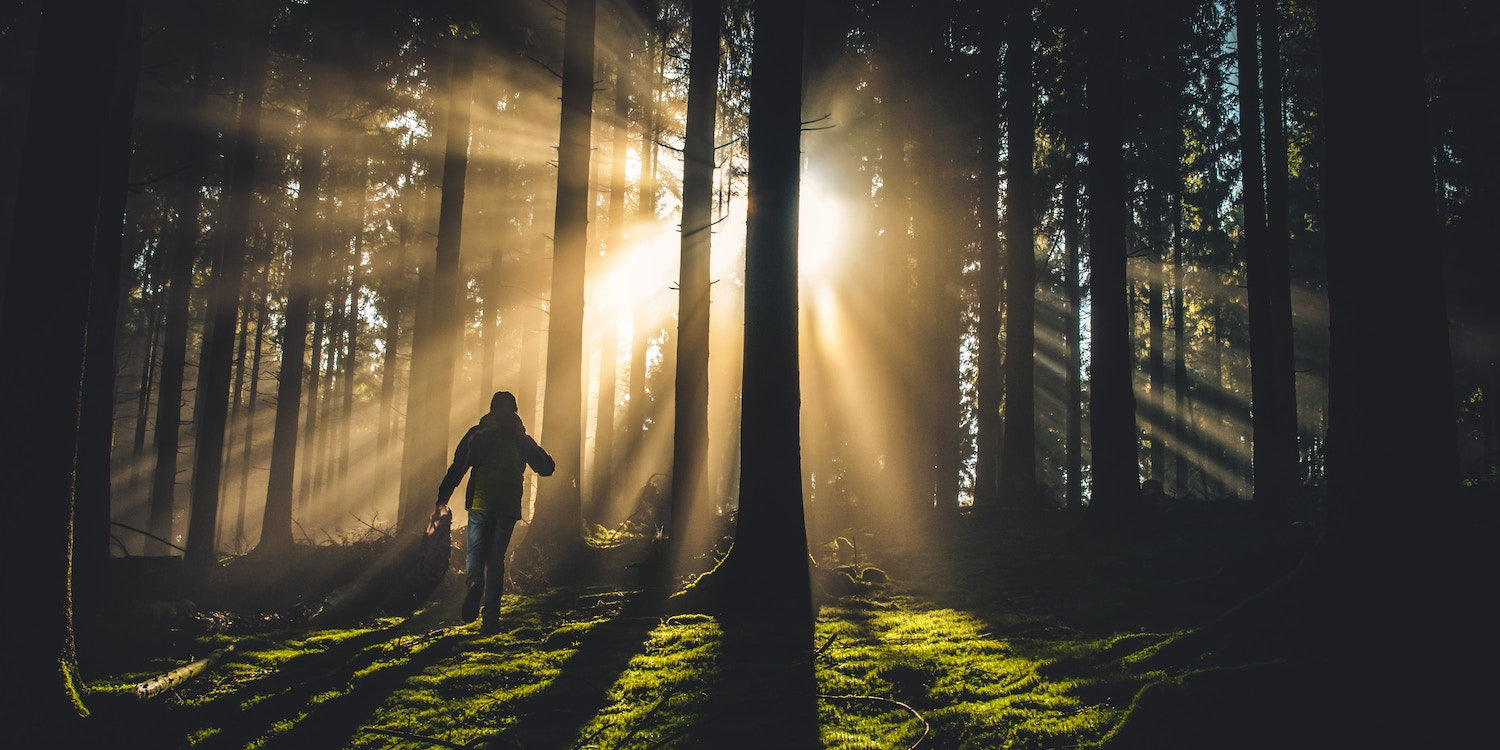Have you heard of forest bathing? If your initial mental image is of rolling around in the dirt, don’t worry — the reality is much more enjoyable.
Forest bathing, also known as shinrin-yoku, is a nature-based mindfulness practice that originated in Japan. These days, it’s becoming more mainstream in countries around the world. And it’s easy to see why: forest bathing can have amazing benefits for the mind and body.
In this post, we’re diving into key points like:
- What is forest bathing?
- Where did forest bathing start?
- What are the mental and physical benefits of forest bathing?
- Can anyone try forest bathing?
- How can I get started with forest bathing?
…and more. By the end, you’ll be ready to head to the woods and have your very first forest bath.
What Is Forest Bathing?
In a nutshell, forest bathing is a way to relieve stress and promote wellness by spending time mindfully taking in nature. Forest bathing typically involves disconnecting from technology, going to a wooded area, and using mindfulness techniques like awareness and deep breathing.
Forest bathing is all about letting the forest wash over you to create an immersive experience. Instead of bathing in water, you “bathe” in the forest using all five senses.
For example, forest bathing might include:
- Seeing the colors of the leaves
- Touching the textures of bark
- Hearing birds chirping or a river bubbling
- Smelling pine needles or damp earth
- Tasting the different quality of the forest air
(And if you have a dog with you, they might even try tasting the forest more fully.)
Integrating all five senses lets you reap benefits you may not get from an ordinary walk in the woods. We’ll go into the benefits of forest bathing in a moment — but first, let’s take a look at how this unique practice got started.
Origins of Forest Bathing
Forest bathing was originally a response to the skyrocketing levels of work stress in Japan in the early 1980s. Japanese leaders noticed that higher work stress was leading to issues like poor mental health and auto-immune diseases.
To combat this crisis, they adapted ancient Buddhist and Shinto customs to create shinrin-yoku, or forest bathing. The practice became popular in Japan, with doctors even writing prescriptions for forest bathing to treat certain ailments.
Today, Japan has over 40 dedicated Forest Therapy trails and is continuing to pioneer research on how spending more time in nature can improve physical and mental health.
The Surprising Benefits of Forest Bathing
Chronic stress and a disconnect from nature aren’t just a 20th century Japan problem — they’re challenges we continue to grapple with today.
A study by the American Institute of Stress found that 55% of adult Americans report feeling stressed during the day. Another study concluded that over 60% of Americans spend 5 hours or fewer outside each week.
Forest bathing offers a low-pressure way to get outdoors while also promoting better health.
Forest Bathing Can Improve Physical Health
In a study spanning 24 forests in Japan, scientists found that people who tried forest bathing had lower blood pressure and heart rate. They also discovered that forest bathing decreased levels of the stress hormone cortisol.
And even more interesting, the participants had lower activity in their sympathetic nervous system (the system that creates stress responses) and more parasympathetic nervous system activity (the system that relaxes your body and handles important tasks like digestion).
Since 2004, multiple studies have also shown that forest bathing increases natural killer (NK) and anti-cancer proteins. These cells can help fight and prevent disease.
To summarize, the physiological benefits of forest bathing can include:
- Lower stress hormones
- Better digestion
- Improved sleep
- Lower blood pressure
- Lower heart rate
- Decreased incidence of disease
- Increased immune function
- A more relaxed body
But forest bathing doesn’t just affect the body. It’s also been shown to have positive effects on the mind, too.
Forest Bathing Can Promote Better Mental Health
The same studies above also examined the effect that forest bathing has on the mind. And good news for outdoors enthusiasts: the results have been overwhelmingly positive.
Forest bathing can have positive psychological effects like:
- Less anxiety
- Less depression
- Relief from anger
- More mental energy
- Improved clarity
- Reduced stress
- A greater sense of connectedness
Some of these benefits come from the practice of mindfulness that’s part of forest bathing. However, the environment of the forest itself is another key factor. The sounds, quiet atmosphere, fresh air, and plant life help you feel more grounded and relaxed.
Getting Started with Forest Bathing
Whether you’re currently at a healthy level of stress or in the midst of a rough patch, forest bathing can be a fantastic resource to help you find balance. So next, let’s go over some FAQs and tips to help you get started.
3 Frequently Asked Questions About Forest Bathing
Here are some of the questions we see most often about forest bathing. And, as always, if you’re interested in diving deeper on the subject, reach out to us any time.
How Long Do You Have to Do Forest Bathing to See Benefits?
There are two parts to this question: how long and how often. There’s no right or wrong answer here, but we’ll share what we’ve learned.
The first part: How long do you have to forest bathe at once for it to work?
Many people try to set aside a longer period of time (say, a couple of hours) if possible. This allows time for the brain to unwind and let go of the constant rush of daily life. Then you can sink into your forest bathing experience and feel more present.
However, even 20 minutes spent in nature has been shown to have powerful positive effects on the mind and body. So if you’re short on time, try a quick forest bathing session and build from there.
That brings us to the second part: How often do you have to go forest bathing?
Forest bathing can help you destress even if you’re only able to do it every once in a while. That being said, making it a consistent part of your routine can:
- Give you a regular self-care session to look forward to
- Create new patterns in your brain to make it easier to use mindfulness
- Help you manage stress on a regular basis
- Build positive coping skills you can use even outside the forest
So if you’re able to, pencil in regular time for forest bathing. It’s a worthwhile investment!
Who Is Forest Bathing For?
Forest bathing is for everyone. Whether you’re an avid outdoorsy type or not, you can participate. It’s suitable for all fitness levels and can help anyone feel less stressed and more present.
For those with limited mobility, virtual forest bathing sessions can offer an accessible way to experience nature.
And if you don’t have access to a forest, you can still connect with nature where you are. You can use the same techniques sitting on your porch, at a park, or even with your window open.
How Is Forest Bathing Different from Hiking?
Hiking is typically more rigorous than forest bathing. And while you are in nature while hiking, there are lots of distractions. You might be chatting with a friend, monitoring your dog, listening to music, or thinking about what to make for dinner.
In contrast, forest bathing is all about pausing, being present, and connecting mindfully with the environment around you. You don’t have to take a strenuous hike to do it (though you can make forest bathing part of a hike). You can simply find a comfortable place to sit or stand and focus on the forest.
Getting Started with Forest Bathing
Whether this is your first time or you’re diving back into the practice, here are five tips to help you get started with confidence.
- Start With a Realistic Goal. Try a short, manageable session at first and make time for future sessions in a way that fits with your lifestyle.
- Put Forest Bathing On Your Calendar. Scheduling your forest bathing time will help you make it a priority and keep other commitments from getting in the way.
- Choose a Location In Advance. Check out what’s around you and choose somewhere that’s accessible for you.
- Pack Your Essentials. Bring weather-appropriate clothing, sturdy shoes, and a reusable water bottle, along with other eco-friendly essentials you may need.
- Put Safety First. Always tell someone where you’re going. If it feels more comfortable for you, bring along a human or canine companion.
How to Try Forest Bathing for the First Time
So, you’ve gathered your supplies, picked your spot, and showed up. Now what?
First, take a moment to find a place where you can comfortably sit or stand for a while.
Next, turn off any devices you have so you can focus without distractions or interruptions.
Once you’re ready, notice the space around you. You can use this mindfulness exercise to ground yourself and connect with the environment.
Ask yourself:
- What can I see?
- What can I hear?
- What can I smell?
- What can I touch?
- What can I taste?
This exercise engages all of your senses and helps you drop into the moment.
Breathing Techniques for Forest Bathing
You might also like to try some calming breathing techniques to help relax your mind and body. Two popular options are box breaths and the 4-7-8 method.
To try box breaths, breathe in through the nose for a count of four, hold your breath for four, exhale for four, hold for four, then inhale again and repeat. Repeat anywhere from four to six times.
The 4-7-8 method is similar. Breathe in through the nose for four, hold your breath for seven, then exhale through the mouth for eight. Repeat several times.
If you feel comfortable, try closing your eyes and breathing quietly for a few moments, noticing how you feel. Besides that, keep your eyes on the beautiful environment around you.
Mindfulness During Forest Bathing
If you feel your mind wandering back to your stressors or to-do list, don’t berate yourself. Simply note the thoughts, let them go, and bring your attention back to your breath and your surroundings.
You may find yourself mentally worn out after the first session, especially if meditation and mindfulness are new to you. That’s perfectly normal. Start with small increments that are manageable for you, then work your way up to longer sessions as you go.
At the end of the day, there’s no one “right” way to forest bathe — you can try different things until you find something that helps you feel your best.
What Is Forest Bathing? A Simple Way to Promote Wellness
We hope this guide helps you feel prepared to give forest bathing a go. Whether you’re looking to reduce stress or just spend more time outdoors, forest bathing is a lovely tool to add to your wellness routine.
Not only does practicing shinrin-yoku help boost your mood, it also gives your body a chance to relax, strengthens your immune system, and can even help you sleep better at night.
So block off some time this weekend and make a beeline for the trees — your first forest bathing session awaits.
Eager to learn more about the benefits of spending time in the forest? Check out these articles:
Resources:
Nature of Americans - Americans and Time Outdoors
Shinrin-Yoku United - Forest Bathing In Japan






